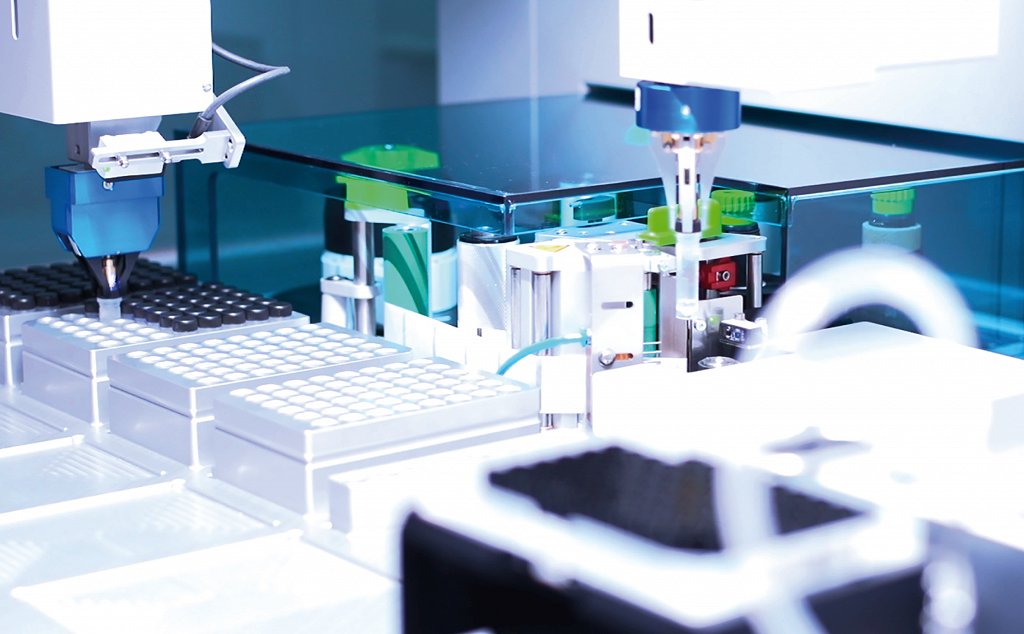Micro-screw tubes as a sample
27.01.2023
Systems dedicated to labeling
 Photo: cab Produkttechnik
Photo: cab Produkttechnik
Convey 180 uncapped tubes. Take liquid from a bottle and distribute into each tube. Pick up screw caps from a tray, seal each tube and check by sensor. Apply a label to each tube. Insert the tubes to racks, starting at position X on rack Y. A cab partner provides solutions for such or similar lab workflows. Pharmacists in research, food and veterinary diagnostics benefit from custom-made automats, operated stand-alone or in an automated lab system. In particular, the opening and closing of tubes is required, added by sorting, filling, scanning, outsourcing. If tubes have to be labeled after filling, the choice are label printers, print and apply systems or laser marking systems by cab, depending on the operation.
Operation based on a HERMES Q
Dispensing liquids from containers into small vessels is a central task of automated filling. There must be no contamination. Liquids must be accurately rated and vessels be reliably labeled. Automated manufacture must take into account the requirements of a planned throughput. If requests are as mentioned in the intro of this text, cab HERMES Q systems are the choice for labeling tubes in machines provided by the cab partner. These print and automatically apply labels in one operation. HERMES Q printers can be combined with a cab applicator or a robot suitable for application. Filling, screwing and labeling 96 tubes takes about 25 minutes with such types of machines. Cycles are shorter in parallel operation, depending on the modular configuration.
Operation based on an AXON 1
Set up a maximum of six racks with a total of 288 tubes, start the machine, done: Another type of machine installs AXON 1 for tube labeling. This print and apply device has been developed by cab specifically for tubes or vials with diameters seven to 26 mm (as much as 38 mm may be possible upon request) and lengths 20 mm to 130 mm. These are inserted in vertical orientation from the top. With a machine configured like this by the cab partner, screwing, dispensing and labeling takes less than an hour in serial processing.
Operation based on a SQUIX 4
In another type of machine, cab SQUIX 4 printers are first choice for tube labeling. The cab partner makes use of peel-off devices. These separate printed labels automatically from their liner. Labels can thus be removed by hand or by an applicator, in this specific case a cylinder drive equipped with a pad. An extra-size metal plate ensures labels be handed over smoothly to the drive cylinder, which then moves with the label towards a tube, held by a gripper. The label is rolled onto the tube by rotation. Labeled tubes are finally inserted to a rack. Liner materials are wound internally on the SQUIX 4 printer.
Laser marking
Cells or functional cell structures can be reliably preserved in the long term only by using cooler systems and optimum stock temperatures as low as -200 °C. Only special label materials withstand such conditions. In such cases, the cab partner selects for marking with a cab XENO 4 fiber laser. This consists of a control unit (beam source included) and a scan head, the latter connected to the beam source. Specific marking fields are covered and laser beams are bundled by assembling a plano-spherical lens to the scan head. By rotating the target object, this is possible even in all-around mode. The cab partner and his customers benefit also from focusing on smallest spots. Markings executed by a cab fiber laser are proof to smudge, acids or alkalis, solvents and UV radiation, heat, cold and tear.
See all these operations in a video on www.cab.de/en/hti-video
For more information, please visit: www.cab.de



































